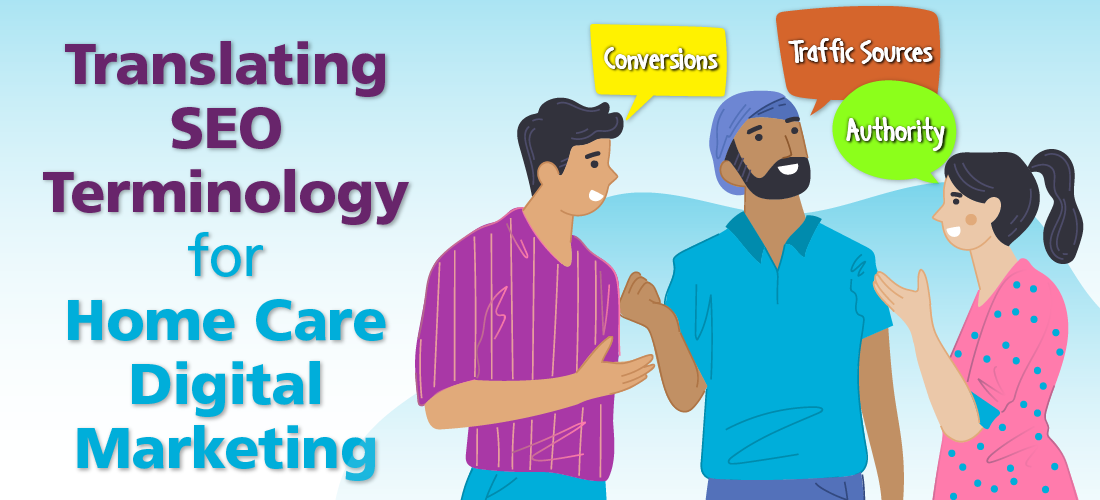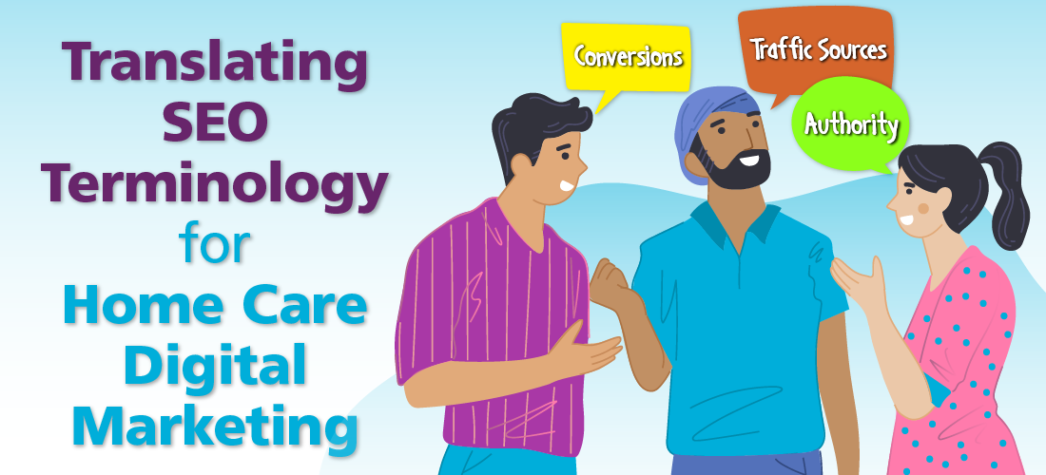
This SEO glossary will help you translate your monthly SEO and PPC reports and your home care digital marketing results.
According to industry data source Home Care Pulse, if your home care company has experienced growth, you are already using a combination of strong search engine optimization (SEO) and pay-per-click (PPC) tactics as part of your overall home care digital marketing strategy. Your digital marketing provider shares detailed reports with you monthly. The metrics seem meaningful. But can you easily translate the SEO terminology and interpret all of the data?
If you feel lost in the lingo, our home care digital marketing specialists have broken it down so you can better understand what your monthly digital marketing reports reveal. You will also gain greater understanding of how your provider is moving the needle for your agency – or not.
Translating Traffic
- Organic Traffic: This term refers to visitors who found your website by searching for specific information (senior care near me) or an answer to a problem (how do I help an elderly parent). Organic search visitors are typically high-quality leads with higher conversion rates.
- Google My Business Traffic: This traffic type isn’t always classified as its own category, but it’s helpful if it is. Often it’s lumped in with “organic” traffic. When it’s separated from organic traffic, you can see how many website visitors clicked your Google Business Profile first and then clicked the link from there to your website.
- Paid Traffic: Paid traffic refers to visitors who reach your website as a result of paid advertisements (PPC) like Google ads.
- Social Traffic: This is traffic coming to your website from social channels like Facebook, LinkedIn, Instagram, and others. For example, when someone clicks a Facebook post that leads them to your website, their visit gets counted as social traffic.
- Referral Traffic: This type of traffic refers to visitors who arrive on your website as a result of clicking a link on another website.
- Direct Traffic: Direct traffic is Google’s “catch-all” bucket. These are website visitors who arrived on your site as a result of typing your website address (URL) into the browser or using a saved bookmark. Also, if Google is unable to identify the source of a website visit, it will go into this bucket. Some examples include traffic from email marketing campaigns or offline documents like PDF, Word, or Excel.
SEO ABCs
- Engagement: Engagement data shows how visitors interact with your website, and is measured by:
- Average Session Duration – How much time visitors spend browsing through your website each time they visit
- Bounce Rate – How many visitors land on your site but leave without any interactions
- Pages per Session – How many average pages visitors view on your site
- Returning Visitors – Visitors who have visited your website multiple times
- Scroll Depth – How much of your content visitors are reading
- Conversion Actions: A conversion action is when someone makes contact with you by:
- Calling the phone number on your website
- Emailing you via the email address listed on your website
- Chatting online via a chat feature, if one is installed on your site
- Filling out and submitting your online contact form
- Completing and submitting an employment application
There are variances in what constitutes a “conversion action” from one digital marketing provider to the next. Be sure to ask your provider what they’re tracking as conversions – if they are, in fact, tracking conversions at all. This is not an automatic process, and requires your provider to utilize tracking tools, such as Google Analytics or Google Tag Manager.
Also note that website conversion actions are different from actual new clients started. It’s important to regularly give your digital marketing provider feedback about whether website conversions are translating to sales and what types of inquiries you are receiving. A good digital marketing provider will use intel from sales conversions and inquiries to make improvements to your digital marketing plan.
- Keywords: Your keyword list includes words or phrases someone may type into a browser’s search bar when looking for the type of services offered by your company. Your digital marketing provider should show you an overview of all keywords your website is ranking for in search results. They should also be able to show you a list of keywords they have specifically chosen to target for your website based on research in your target market areas. This second list is the focus for use on-page and in metadata across your website. It should be closely monitored and updated over time based on keyword performance.
- Sessions vs. Users: In a nutshell, ”users” represent unique visitors to your website, while “sessions” represent visits, or the number of times those users have come to your site. You can also look at the channel breakdowns for sessions to see if they came from organic search, social, paid search, direct, referral, or your Google Business Profile. And, you can review engagement details, such as how long users are staying on your site for each channel.
- Domain Authority: Domain Authority is a search engine ranking score created by the software development company Moz that predicts how likely a website is to rank in search engine result pages (SERPs). It can help you better understand your site’s credibility in the eyes of the search engines and you can see how you compare to your competition by comparing Domain Authority scores with them.
- Backlinks: Backlinks are links to your website from other websites. You should be able to see how you compare to your competitors in terms of the number of backlinks. It’s important to understand that there are both good and bad backlinks. Good backlinks are those from websites containing highly relevant content with high authority. Bad backlinks, on the other hand, are from websites that are spammy, contain low trust scores and authority, and are unnatural in terms of relevant content. The goal of your digital marketing provider should be to increase good backlinks while removing bad backlinks. Keep in mind that removing bad backlinks should be done carefully and not all at once to avoid possible penalties from Google.
- Site Audit: A site audit gives you an overview of what’s happening behind the scenes of your website: broken internal or external links and images, missing metadata, missing alt attributes (metadata for images), missing or multiple H1 tags, duplicate content, low or high word count, and more. Learn more about these terms.
PPC (Google Ads or Pay-Per-Click) ABCs
While there are some overlapping terms you’ll notice in your PPC and SEO reports, there are additional metrics with PPC to understand and evaluate, such as:
- Industry Averages: This data shows how your website’s performance measures up to industry averages.
- Average Cost-Per-Click: Your average cost-per-click is the cost you’re paying each time someone clicks on your ad. (Note: Don’t click on your own ads, and ask your employees not to do so. Make sure they have your office phone number programmed in their phones so that they aren’t Googling to find it and then inadvertently clicking on your ads and spending your ad dollars.)
- Click-Through-Rate: Click-through-rate (CTR) reveals how many impressions you had (how many times someone saw your ad), and of those impressions, how many people actually clicked on your ad.
- Conversion Rate: Of the number of clicks you received, the conversion rate shows how many people followed through with a predetermined action: calling, emailing, completing a contact form or employment application, etc.
- Cost-Per-Conversion: Your cost-per-conversion is calculated by dividing the amount you’ve spent by the number of conversions received.
- Competitor Insights: This data helps you understand how you measure up against your competitors in terms of:
- Impression Share: The number of impressions received (or the number of times your ad was shown) divided by the estimated number of impressions you were eligible to receive
- Average Position: How often another advertiser’s ad received an impression in the same auction that your ad received an impression
- Position Above Rate: How often another advertiser’s ad in the same auction showed in a higher position than your own, when both of your ads were shown at the same time
- Top of Page Rate: How often your ad was shown at the top of the page in search results
- Outranking Share: How often your ad ranked higher in an auction than another advertiser’s ad, or if your ad was shown when theirs was not
Understanding what your SEO and PPC reports reveal helps you forge a true partnership with your digital marketing provider. It’s best to work with a partner who is willing to help you translate SEO terminology and interpret data together so you can continue to grow your business.
As a Certified Google Partner, our home care SEO and PPC experts have the digital marketing and home care industry expertise to ensure you understand the process every step of the way. Contact us at 800.370.6580 to get started on a home care digital marketing strategy that will help you attract both the clients and caregivers you need to succeed!

